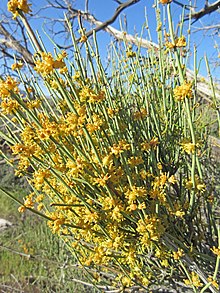

| Ephedraceae
| |
|---|---|

| |
| Ephedra nevadensis | |

| |
| Restoration of Arlenea from the Early Cretaceous of Brazil | |
| Scientific classification | |
| Kingdom: | Plantae |
| Clade: | Tracheophytes |
| Clade: | Gymnospermae |
| Division: | Gnetophyta |
| Class: | Gnetopsida |
| Order: | Ephedrales Dumort.[2] |
| Family: | Ephedraceae Dumort.[1] |
| Type genus | |
| Ephedra
| |
| Other genera | |
|
See text | |
Ephedraceae is a family of gymnosperms belonging to Gnetophyta, it contains only a single extant genus, Ephedra, as well as a number of extinct genera from the Early Cretaceous.
Ephedraceae is agreed to be the most basal group amongst extant gnetophytes. Members of the family typically grow as shrubs and have small, linear leaves that possess parallel veins. The fossil Ephedraceae genera show a range of morphologies transitional between the ancestral lax male and female reproductive structures and the highly compact reproductive structures typical of modern Ephedra.[3][4] Modern members of Ephedra have either dry winged membranous bracts (modified leaves which surround the seed), which are dispersed by wind, leathery covered seeds, which are dispersed by seed-eating rodents, or fleshy bracts which are consumed and then dispersed by birds. Some extinct members of Ephedra from the Early Cretaceous, such as Ephedra carnosa, as well as Arlenea from the Early Cretaceous of Brazil have fleshy bracts surrounding the seeds, suggesting that these seeds were dispersed by animals.[5]
| Ephedraceae |
|
|---|---|
| Ephedrales |
|
| Authority control databases: National |
|
|---|